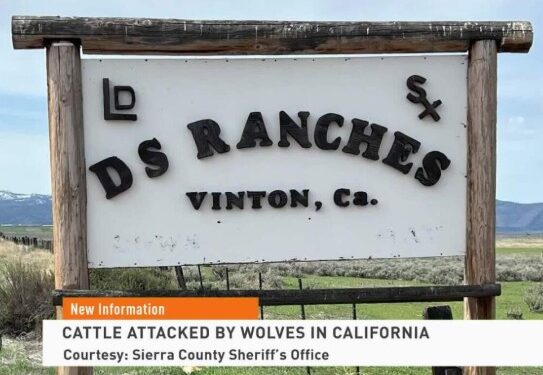By Cris Alarcon, InEDC Writer. (April 25, 2025) — SISKIYOU COUNTY, Calif. — The resurgence of gray wolves in Northern California has reignited age-old tensions between wildlife conservation efforts and the livelihoods of ranchers. As wolf populations grow, so do concerns over livestock safety and economic impacts in rural communities.
Joel Torres, a herdsman at Prather Ranch in Siskiyou County, has witnessed firsthand the devastating effects of wolf predation. “They’ve just been tearing into our baby calves, mostly our yearlings,” Torres said. Unlike predators that kill swiftly, wolves often attack from behind, inflicting gruesome injuries that leave cattle in shock and agony. Torres has had to euthanize numerous injured animals, describing the ordeal as a “nightmare” for both the cattle and the ranchers.
The return of wolves to California began in 2011 when a wolf from Oregon, known as OR7, crossed into the state. Since then, seven distinct packs have been established, primarily in the northern regions. The Whaleback pack, in particular, has been linked to significant livestock losses at Prather Ranch and neighboring operations.
A study by researchers at the University of California, Davis, analyzed over 100 wolf scat samples from the Lassen pack between 2022 and 2023. The findings revealed that 72% of the samples contained cattle DNA, indicating a substantial reliance on livestock as a food source
In response to the escalating conflicts, the California Department of Fish and Wildlife (CDFW) has implemented non-lethal deterrents, including firing guns into the air, using drones, and deploying range riders to monitor and protect herds. However, ranchers like Torres remain skeptical of these measures’ effectiveness. “The wolves just jump over those fences,” he noted, referring to electric fences with red flags intended to deter the predators.
To mitigate the financial burden on ranchers, the state launched the Wolf-Livestock Compensation Program in 2021, allocating $3 million to reimburse producers for confirmed or probable wolf-related livestock losses. By March 2024, all funds had been disbursed, with 109 grants awarded to producers in areas of known wolf activity, including Siskiyou, Lassen, Plumas, and Tulare counties . An additional $600,000 was appropriated in 2024, focusing solely on direct loss compensation
Despite these efforts, many ranchers feel the compensation falls short, especially considering indirect losses such as decreased cattle weight and increased stress-induced abortions. “Cows don’t usually run 10 miles over four hours in the middle of the night,” said UC Davis researcher Kenneth Tate, highlighting the abnormal behavior caused by wolf presence.
The growing wolf population has also raised public safety concerns. In Modoc, Lassen, and Sierra counties, officials have reported wolves venturing closer to residential areas, scavenging human trash, and even charging at individuals. These incidents have prompted the CDFW to consider reviewing the gray wolf’s endangered species status, a process that could lead to policy adjustments
Mary Rickert, co-owner of Prather Ranch, advocates for more aggressive measures to protect livestock. “We’d just pick off a few of the bad actors, so the others would go, whoa, and back off,” she suggested.
As California grapples with balancing ecological restoration and agricultural interests, the debate over wolf management continues to intensify. For ranchers like Torres, the return of these apex predators represents not just a challenge to their livelihood but a profound test of coexistence in the modern West.









